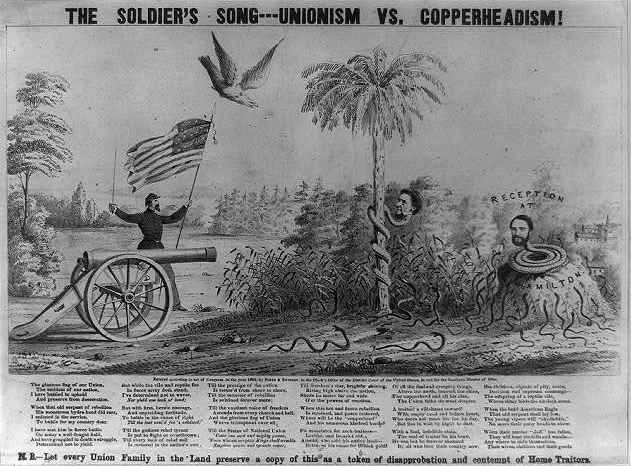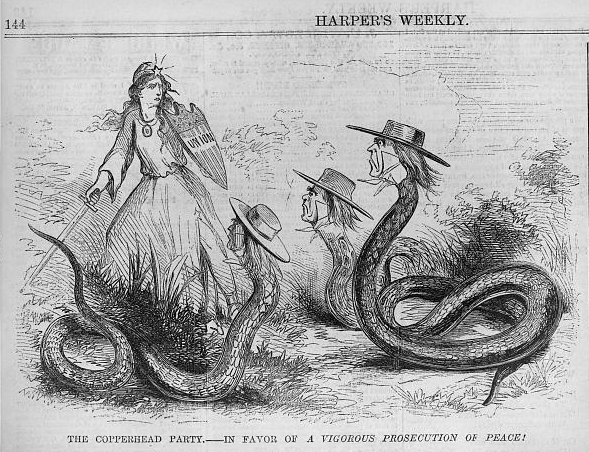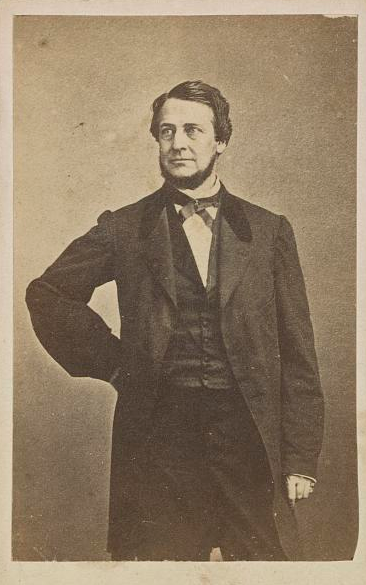During the , the “Copperheads” were Northern Democrats who opposed United States government efforts to suppress the Confederate rebellion. A significant portion of the Democratic Party in Indiana and Indianapolis believed the federal government lacked constitutional authority to coerce a seceded state back into the Union. They believed the Constitution sanctioned the existence of slavery, and therefore the rebels had right on their side when they seceded in order to protect slavery. For these reasons, and because they viewed many of President Abraham Lincoln’s war measures to be unconstitutional and illegal, some “Copperheads” formed secret organizations and conspired to subvert the war effort.

Indiana Democrats during the Civil War exhibited a spectrum of ideological views. The split among factions that variously defended strict state sovereignty and a more moderate view that held that states had rights but that the Confederates had exceeded them in rebelling. A more nationalist faction, “War Democrats,” allied with Republicans in supporting the war to suppress the rebellion. Regardless of where they stood on the question, Indiana Democrats generally feared that the espoused radical social and economic views (e.g., abolition of slavery, a central bank, paper money, government intervention in the economy) anathema to them.
Some anti-war Democrats combined in secret groups to subvert war measures that would entangle them with the war effort (e.g., conscription). Others joined those secret organizations for protection against violence from Republican partisans and soldiers who lashed out at Democrats. A smaller but still substantial set of anti-war Democrats knowingly conspired with Confederate rebels to subvert the Union war effort.
Early in the war, reports arose that secret societies existed across the North whose members opposed the war of coercion and supported the Confederates. One such society was Knights of the Golden Circle (KGC), established in the 1850s in Cincinnati to promote the spread of slavery in Latin America and the Caribbean. In Indiana, state government officials believed that these groups discouraged men from enlisting in military forces and promoted resistance to government measures.
Evidence of the existence of the Knights in Indianapolis emerged in the summer of 1862, when John Hanna, the U.S. attorney for Indiana, developed a grand jury report on the secret group’s activities in the state. In January 1863, he obtained testimony from an Indianapolis attorney who confessed to KGC membership and that the local KGC “lodge” met regularly. Hanna heard testimony from KGC members from other parts of the state that KGC members talked in their local secret meetings about marching on Indianapolis, seizing the state arsenal as well as Governor Morton.

At this time the military commander in Indianapolis, Col. (later Brig. Gen.) Henry B. Carrington, discovered that soldiers stationed in camps around the city were members of the KGC. The organization offered soldiers the means to desert and thereby weaken the U.S. Army and its ability to put down the rebellion. He viewed the Knights as a threat to the integrity of the army and worked closely with Gov. Morton to combat the organization’s influence.
In spring 1863, desertion increased dramatically and armed groups around Indiana and other states violently resisted the arrest of deserters and draft dodgers. Employing military force, Carrington arrested many persons for aiding deserters and obstructing arrests and sent their cases to the federal district court in Indianapolis, winning many convictions. In a public statement, he blamed the spike in army desertions on the Knights and said he had obtained insider information on the group, which he characterized as disloyal and dishonorable. He published information on the KGC in the , the chief Republican newspaper.
Later, Carrington asserted that his investigations and pronouncement in 1863 effectively demoralized the KGC. Other factors may have weighed on the secret organization. Most notably, in July 1863, its founder, George W. L. Bickley, was arrested in southern Indiana and imprisoned for the rest of the war when he attempted to travel up from the Confederacy, where he had sojourned and served in Confederate forces.
Sometime in the late summer or early fall of 1863, perhaps because of its demoralization and disorganization, the Knights of the Golden Circle reorganized across the northern states. It took the new name, the Order of American Knights (OAK), and sported new secret rituals and other trappings. It had a military organization, with membership organized into companies, regiments, and brigades. Evidence suggests its Indiana leadership remained constant. , an Indianapolis businessman, prominent Democrat, and leader of the KGC in Indiana, continued as “grand commander” of the OAK. An employee in his printing firm, Dodd & Co., located at 16 ½ E. Washington Street, served as secretary of the OAK and maintained the organization’s records in company offices.
The OAK continued the KGC’s goal of subverting the federal government’s war effort. In the fall of 1863, military intelligence uncovered an OAK plot to attack Indianapolis, seize Camp Morton and military arsenals, and free and arm the Confederate prisoners held there. Army officers and Gov. Morton took the threat seriously and took steps to counteract it. Because of its dual status as the seat of state government and a military center, Indianapolis continued to be a target.
The organization continued under the OAK name for only a few months until, in February 1864, at a meeting held in New York City, Dodd and other state leaders of the OAK changed its name to the Sons of Liberty (SoL). (The state organization in Missouri retained the OAK name, however, leading to much confusion on the part of historians.) Dodd continued as grand commander in Indiana, and Ohio anti-war firebrand Clement L. Vallandigham was installed as “Supreme Commander.” Some rituals and other trappings changed, but organizational continuity from KGC to OAK to Sons of Liberty remained.

Military intelligence learned of the name change and the new leadership in time, thanks to the infiltration of secret meetings by spies and informants. Their reports established that SoL membership was around 100,000 statewide and that top elected officials were members.
Beginning in May 1864, Gen. Carrington had a spy highly placed in the organization in Kentucky, who regularly reported on plots shared with Indiana leadership and who attended secret meetings in Indianapolis. Against the wishes of military commanders, Gov. Morton had organizational records smuggled out by the spy published in the Indianapolis Daily Journal. The spy also reported that SoL leaders were in regular communication with Confederate agents operating out of Canada and Confederate guerrillas in Kentucky. They planned another attack on Indianapolis by Sons of Liberty members to free Confederate prisoners, this time to coincide with raids from Confederate forces across the Ohio River. The attack was to occur on August 16.
On that day, armed men arrived in the city in preparation for an attack on the prison camp. The assault did not take place, however, as the unexpected arrival of federal troops in the city intimidated plotters. As well, prominent Democratic politicians, alerted to the revolutionary conspiracy, succeeded in postponing action. One of those Democrats, former Congressman , secretly alerted Gen. Carrington and suggested that he arrest the leading plotters.
Days later, an informant alerted Gov. Morton that a large shipment of arms and ammunition was en route from New York City consigned to Dodd. Military officers searched Dodd’s warehouse and the railroad depot and found boxes labeled “stationary” [sic] full of 400 revolvers and 135,000 rounds of ammunition. They also found records of the secret organization. Morton alerted authorities in New York who found the remainder of the shipment containing another 2000 revolvers.
Troops arrested several of Dodd’s employees. Dodd himself was absent from the city. Military forces arrested him on his return to Indianapolis in early September. Morton had many seized records published in the Republican newspaper, which caused a stir. With the approval of President Lincoln, military commanders in Indianapolis put Dodd on trial by military commission for disloyalty and conspiracy (see ). In the trial held in the city, a group of military officers found Dodd and others guilty and sentenced them to death.
By that fall, during the military commission trials, Gen. Carrington detected a residual element of the secret group reorganized as the “Star Organization.” But repeated exposure and arrests had effectively broken the KGC/OAK/SoL secret organization and its genuine threat to the Union war effort. While for many years historians dismissed the existence of subversive secret societies and their threat to the federal government, research has established that the organizations were real, widespread in the North, and threatened the ability of the government to suppress the Confederate rebellion.

Help improve this entry
Contribute information, offer corrections, suggest images.
You can also recommend new entries related to this topic.